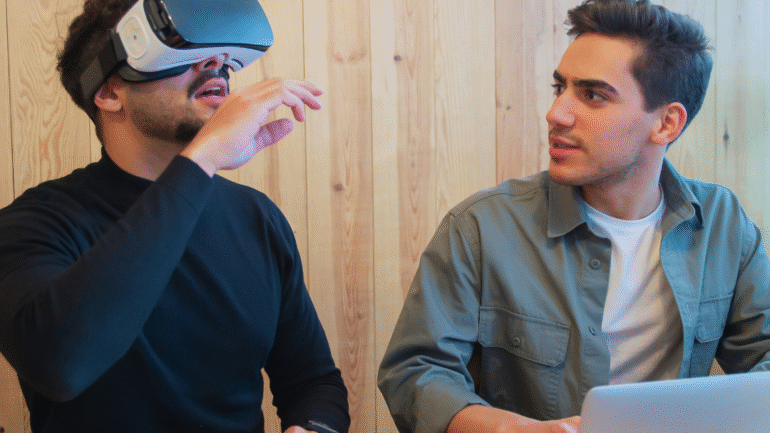The retail landscape is rapidly evolving, driven by advancements in technology. Among these, the integration of augmented reality (AR) and virtual reality (VR) is transforming shopping experiences, allowing consumers to interact with products in innovative ways. This technology enhances consumer engagement by providing immersive experiences that blend the digital and physical worlds, ultimately reshaping purchasing behavior.
Incorporating AR and VR into shopping not only optimizes the decision-making process but also personalizes experiences to meet individual preferences. Brands are leveraging these tools to create virtual showrooms and fitting rooms, where customers can visualize products in real-time from the comfort of their homes. This shift not only boosts customer satisfaction but also increases conversion rates, offering a competitive edge in a crowded marketplace.
As retailers continue to embrace these technologies, they are redefining the relationship between consumers and products. By seamlessly integrating AR and VR, businesses can create interactive experiences that draw customers in, encouraging deeper exploration and interaction with their offerings. The future of shopping is here, and it is both immersive and engaging.
Understanding AR and VR Technologies in Shopping
The integration of augmented reality (AR) and virtual reality (VR) into shopping experiences marks a significant advancement in how consumers engage with products. These technologies enhance both digital and physical retail environments, creating immersive experiences that transform consumer behavior and shopping dynamics.
Overview of Augmented Reality and Virtual Reality
AR technology superimposes digital information onto the real world, allowing consumers to visualize products in their actual environment. Examples include mobile apps that let shoppers see how furniture fits in their homes.
VR technology, on the other hand, provides a fully immersive experience. Users can explore virtual stores as if they were physically present. This allows for a more interactive shopping experience, where customers can engage with 3D models of products.
Both technologies rely on sophisticated hardware and software, enabling seamless integration into e-commerce platforms and brick-and-mortar stores.
Evolution of Immersive Technologies in Retail
The rise of AR and VR in retail is a response to changing consumer expectations for interactive experiences. Initially, these technologies were considered novelties. However, advancements in mobile computing and internet speeds have fueled their adoption.
Retailers have begun adopting these technologies to bridge the gap between online and offline shopping. For instance, AR has allowed online retailers to minimize return rates by giving customers a clearer idea of product dimensions and aesthetics before purchase.
As the digital landscape evolves, the demand for immersive technologies continues to grow, reshaping traditional shopping methodologies.
How AR and VR Transform Shopping Experiences
AR and VR technologies significantly enhance the shopping experience by personalizing interactions and providing real-time information. For instance, consumers can use AR apps to scan products for detailed specifications or customer reviews, enriching their decision-making process.
In VR, customers can participate in virtual fashion shows or tours of stores that aren’t physically accessible to them. The emotionally engaging experiences fostered by these technologies can also lead to increased brand loyalty.
By integrating AR and VR into their strategies, retailers are not only enhancing customer engagement but also driving sales through innovative online retail solutions.
Applications of AR and VR in Retail and E-commerce
The integration of augmented reality (AR) and virtual reality (VR) technologies in retail and e-commerce is transforming customer experiences. These technologies enhance engagement and facilitate informed purchasing decisions through various innovative applications.
Virtual Try-On and Fitting Rooms
Virtual try-on solutions allow customers to see how products will look on them without physical contact. This technology is widely used in the fashion and cosmetics industries. Users can upload images of themselves or use their device’s camera.
AR fitting rooms also enhance the shopping experience for furniture and home décor. Customers can visualize how a chair or sofa fits in their living space. This capability increases confidence in purchase decisions, reducing return rates.
Interactive Product Visualization and Virtual Showrooms
Interactive product visualization enables customers to explore products in three dimensions. Retailers can showcase items from different angles and with various features. This immersion helps in understanding product details, such as textures, dimensions, and colors.
Virtual showrooms offer entire brand experiences in a digital space. Consumers can browse virtual storefronts and interact with products as if they were physically present. This approach is beneficial for high-involvement products like luxury items or intricate home décor.
Gamification and Immersive Storytelling
Gamification incorporates game elements into the shopping experience to increase engagement. Retailers can create challenges or quizzes related to their products. These activities encourage consumers to participate actively in brand storytelling.
Immersive storytelling enhances customer connections with brands through engaging narratives. Retailers use AR and VR to create experiences that resonate emotionally. This tactic captures attention and fosters a sense of loyalty among consumers.
Personalized Shopping Experiences and Consumer Engagement
Personalized experiences leverage data to tailor offerings to individual shopper preferences. AR solutions present products that align with user interests, enhancing the likelihood of conversion.
Consumer engagement thrives through immersive experiences that create memorable interactions. By combining AR and VR with customer data, retailers can provide unique pathways to discover products. This approach not only captivates shoppers but also encourages repeat visits and long-term loyalty.
Business Impact of AR and VR Integration
The integration of augmented reality (AR) and virtual reality (VR) has transformed the retail landscape, influencing consumer behavior and reshaping marketing strategies. These technologies enhance customer satisfaction while fostering brand loyalty and recognition.
Influence on Consumer Behavior and Customer Satisfaction
AR and VR create immersive shopping experiences that significantly enhance consumer engagement. Customers can visualize products in real-world settings, leading to more informed purchase decisions. For instance, virtual try-on features allow users to see how clothing fits without trying it on physically.
This interactive approach reduces the chances of returns and increases satisfaction. Companies report a higher Customer Satisfaction Score (CSAT) when using AR and VR features. Additionally, studies show that consumers are more likely to recommend brands that utilize these technologies.
Businesses leveraging AR and VR can expect increased Consumer-Brand Interaction, enhancing brand loyalty and long-term relationships with customers.
Brand Loyalty, Recognition, and Marketing Strategies
The immersive nature of AR and VR not only captures attention but also strengthens brand recognition. These technologies allow brands to differentiate themselves through unique marketing strategies. Use of interactive advertising leads to deeper connections with consumers, fostering loyalty.
Brands that adopt AR and VR in their marketing efforts witness a significant increase in recognition metrics. CAGR (Compound Annual Growth Rate) projections for the AR and VR market indicate a growing investment in these technologies by retailers.
Through these innovative strategies, brands can maintain relevance in competitive markets, solidifying customer loyalty and enhancing overall marketing effectiveness.
Challenges and Future Trends
The integration of AR and VR in shopping experiences faces significant challenges that need addressing. Key concerns include data privacy and security, advancements in technology such as 5G networks, and varying market opportunities across different regions.
Data Privacy and Security Concerns
As AR and VR technologies become more prevalent in retail, the handling of personal data raises critical privacy issues. Consumers may hesitate to engage with AR applications if they are unsure of how their data is being used and stored.
Organizations must ensure robust data protection measures are in place. Breaches can lead to substantial financial penalties and reputational damage. Implementing strong encryption and regularly updating security protocols is essential.
In addition, regulations such as GDPR must guide data management practices. Companies will benefit from transparent communication about data use, which can help ease consumer concerns.
Technological Advancements and 5G Networks
5G networks are poised to significantly enhance AR and VR experiences by enabling faster data transfer and reduced latency. This improvement will facilitate more immersive shopping experiences, such as virtual test drives of vehicles or 3D product showcases.
With 5G capabilities, retailers can adopt advanced technologies like artificial intelligence and machine learning for personalized consumer interactions. The increased bandwidth can support real-time rendering of 3D models, enhancing the realism of digital products.
As VR hardware continues to improve, customers can expect higher quality visuals and seamless experiences. This advancement has the potential to reshape how retail engages customers, leading to higher conversion rates and lower product return rates.
Regional Analysis and Market Opportunities
The Asia Pacific region presents significant opportunities for AR and VR shopping experiences. Rapid technological advancements and high internet penetration create a fertile ground for these innovations.
Consumers in this region are particularly receptive to immersive experiences offered by platforms like Snapchat. Retailers can leverage these technologies in markets with growing middle classes and urban populations.
Regions will differ in their adoption rates of AR and VR. Retailers should tailor their strategies based on local consumer behavior and technological readiness. Identifying key markets allows for more effective content creation and implementation of AR/VR platforms, maximizing investment potential.





